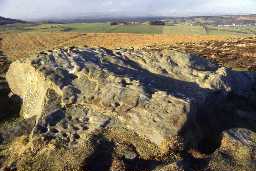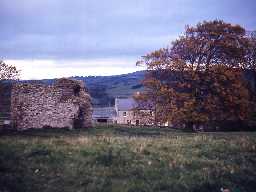Local History
Whitton and Tosson (Northumberland)

Cup and ring marked stone at Lordenshaws. Photo by Northumberland County Council.

Tosson Tower. Photo by Harry Rowland.
Tosson parish is an irregular shape and has a landscape that ranges from flat haugh lands to the Fell Sandstones. Archaeologically, there are a rich variety of sites and finds from prehistoric rock carvings to World War II pillboxes.
Prehistoric remains abound, with many burial and ritual monuments dating to the Neolithic and Bronze Age periods. They include mysterious Neolithic rock carvings called cup and ring marked stones. They are common on the Fell Sandstones of Northumberland with examples near the Whitton Burn and Lordenshaws. A standing stone, stone setting and cup and ring marked stone near Whittondean Farm suggests various activities were taking place around the prehistoric rock art.
Many Bronze Age cairns have been discovered by excavation in the late 19th and 20th century. These have often revealed a central cist with pottery and flint grave goods, such as at Spital Hill. A cist cemetery discovered at Great Tosson revealed four cists during quarrying operations in the 19th century. A famous Bronze Age hoard was found beneath the summit of Simonside and a bronze axe has been found near Burgh Hill. Presumably there were some Bronze Age settlements in the area but they remain undiscovered.
Iron Age and Roman settlement is more widespread. The hillfort on Burgh Hill overlooks the village of Great Tosson and Roman farmsteads on Birky Hill and east of Spital Hill overlook the lower slopes and river lands. The extent of Roman influences is unknown in Tosson, but it is likely some contacts were made as the Roman road linking High Rochester and Low Learchild runs further to the north and Roman glassware has been found in a neighbouring parish at Witchy Neuk hillfort.
One of the few early medieval sites in this part of Northumberland was found at Great Tosson. A Bronze Age cist had been reused from a cist cemetery. Unfortunately no settlements have been discovered from this period.
In medieval times, people lived in small villages and hamlets at Newton, Little Tosson, Ryehill and Great Tosson. Farms were established at Newtown West and a monastic sheep farm at Whittondean Farm. Later, temporary buildings called shielings were built for shepherds tending sheep on high summer pastures, such as at Croppy's Hole. A medieval hospital was established at Allerdene in the 13th century, under the auspices of Newminster Abbey in Morpeth. Northumberland suffered during the wars with Scotland in the 13th and 14th centuries and some people built defensive homes called tower houses at Great Tosson and Whitton.
The turmoil of the medieval period was echoed in the post-medieval period with fierce feuds between border families called reivers. Those who could afford it built defended farmhouses called bastles and many of these survive across western Northumberland either as ruins or as conversions into later, more comfortable farmhouses, such as Newtown Bastle, Whitton Farmhouse and Whitton Farm North Cottage.
Agricultural improvements in the 18th and 19th century can be seen in the lime kilns at Whitton Glebe Farm and Tosson. Several industries sprang up with lead mining and coalmining at Whittondean and a woollen mill at Tosson. In more recent times, a line of pillboxes was built at Carterside, Ryehill and Newtown, forming the Coquet Stop Line.
Prehistoric remains abound, with many burial and ritual monuments dating to the Neolithic and Bronze Age periods. They include mysterious Neolithic rock carvings called cup and ring marked stones. They are common on the Fell Sandstones of Northumberland with examples near the Whitton Burn and Lordenshaws. A standing stone, stone setting and cup and ring marked stone near Whittondean Farm suggests various activities were taking place around the prehistoric rock art.
Many Bronze Age cairns have been discovered by excavation in the late 19th and 20th century. These have often revealed a central cist with pottery and flint grave goods, such as at Spital Hill. A cist cemetery discovered at Great Tosson revealed four cists during quarrying operations in the 19th century. A famous Bronze Age hoard was found beneath the summit of Simonside and a bronze axe has been found near Burgh Hill. Presumably there were some Bronze Age settlements in the area but they remain undiscovered.
Iron Age and Roman settlement is more widespread. The hillfort on Burgh Hill overlooks the village of Great Tosson and Roman farmsteads on Birky Hill and east of Spital Hill overlook the lower slopes and river lands. The extent of Roman influences is unknown in Tosson, but it is likely some contacts were made as the Roman road linking High Rochester and Low Learchild runs further to the north and Roman glassware has been found in a neighbouring parish at Witchy Neuk hillfort.
One of the few early medieval sites in this part of Northumberland was found at Great Tosson. A Bronze Age cist had been reused from a cist cemetery. Unfortunately no settlements have been discovered from this period.
In medieval times, people lived in small villages and hamlets at Newton, Little Tosson, Ryehill and Great Tosson. Farms were established at Newtown West and a monastic sheep farm at Whittondean Farm. Later, temporary buildings called shielings were built for shepherds tending sheep on high summer pastures, such as at Croppy's Hole. A medieval hospital was established at Allerdene in the 13th century, under the auspices of Newminster Abbey in Morpeth. Northumberland suffered during the wars with Scotland in the 13th and 14th centuries and some people built defensive homes called tower houses at Great Tosson and Whitton.
The turmoil of the medieval period was echoed in the post-medieval period with fierce feuds between border families called reivers. Those who could afford it built defended farmhouses called bastles and many of these survive across western Northumberland either as ruins or as conversions into later, more comfortable farmhouses, such as Newtown Bastle, Whitton Farmhouse and Whitton Farm North Cottage.
Agricultural improvements in the 18th and 19th century can be seen in the lime kilns at Whitton Glebe Farm and Tosson. Several industries sprang up with lead mining and coalmining at Whittondean and a woollen mill at Tosson. In more recent times, a line of pillboxes was built at Carterside, Ryehill and Newtown, forming the Coquet Stop Line.
N13765
UNCERTAIN
Disclaimer -
Please note that this information has been compiled from a number of different sources. Durham County Council and Northumberland County Council can accept no responsibility for any inaccuracy contained therein. If you wish to use/copy any of the images, please ensure that you read the Copyright information provided.